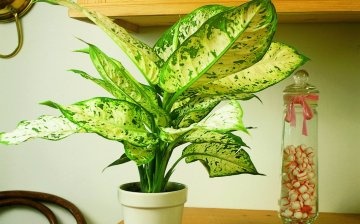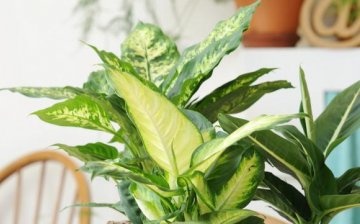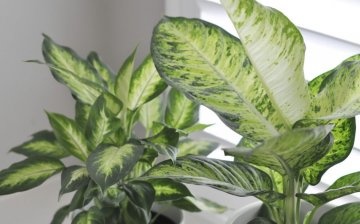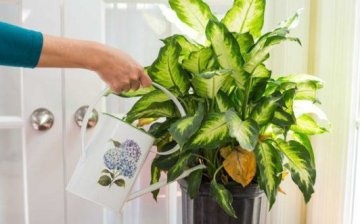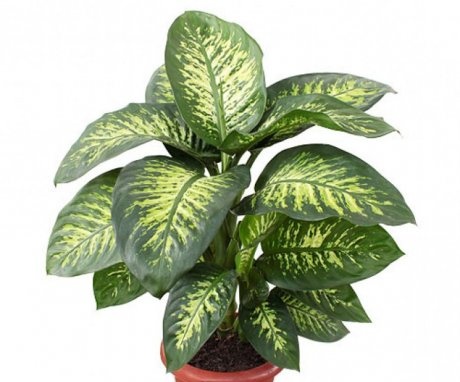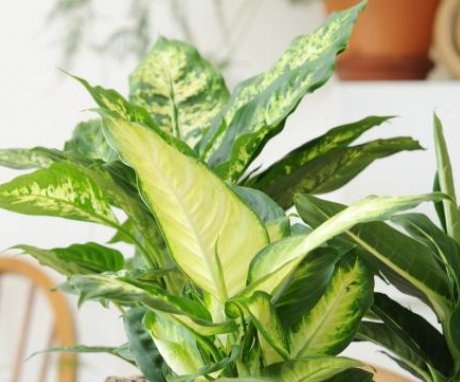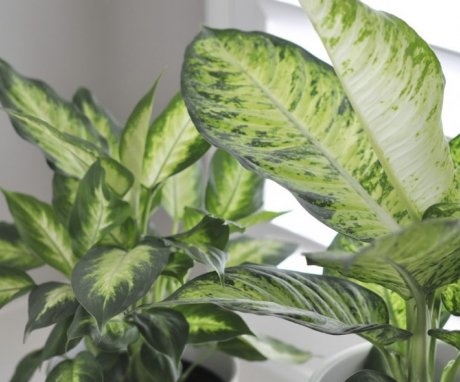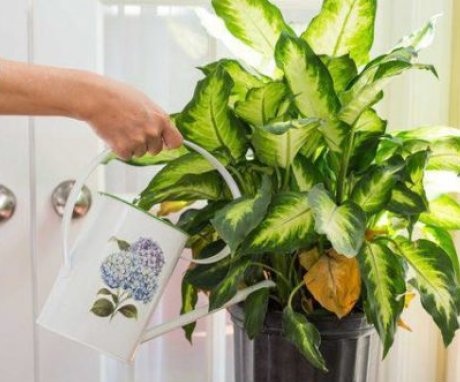Is it possible to keep dieffenbachia at home: the benefits and harms of the plant
Dieffenbachia is a common house plant, around which more rumors, legends and superstitions have been circulating for a long time. This plant has large, beautiful leaves with light to dark green tints. The most popular is spotted dieffenbachia. However, many are afraid to keep this flower at home, fearing bad omens and negative influences. Growing this plant has its own characteristics, but if you follow the rules, you can grow a beautiful flower and avoid unpleasant consequences.
Content:
- Features of a houseplant
- The benefits and harms of dieffenbachia
- Growing and breeding conditions
- Possible problems and diseases of dieffenbachia
Features of a houseplant
Dieffenbachia belongs to the perennial plants of the aroid family. In their natural environment, they can be found in tropical forests, where it is humid and warm enough. The most common wild dieffenbachia is found in South America. Not all types of this plant are decorative. Dieffenbachia spotted is more often used as indoor flowers.
There are many superstitions about whether it is possible to keep dieffenbachia at home. This is due not only to the fact that the sap of this plant is very poisonous. An unusual flower has long been endowed with magical powers.
Until now, many believe that keeping this flower at home is not good.
Dieffenbachia has several characteristic features:
- Different types of dieffenbachia may differ in leaf color. All plants have a fleshy stem and a well-developed root system. Leaves are usually large, matte or shiny. At home, varieties with different patterns and spots on the leaves are usually bred, as they look original.
- A feature of this plant is its rapid growth. A new leaf appears on the stem weekly. Dieffenbachiae can reach a height of 2 m with proper care. However, it must be remembered that as the plant grows, the trunk of the plant is exposed, which does not look so decorative anymore.
- Dieffenbachia propagation does not require much effort. Under natural conditions, the flexible trunk bends to the soil and takes root on its own. If the top of the plant breaks off, it can be easily rooted to create another plant.
- Dieffenbachia blooms around mid-summer. However, it is not so easy to make this flower bloom at home. Few gardeners strive to achieve flowering, since small light buds do not add any decorative effect to the plant. Flowering is rather given some magical meaning.
The name of this plant was given by the Austrian botanist Schott in honor of another German botanist Dieffenbach. The domestication of Dieffenbachia began over 100 years ago. But it is recommended to keep it away from pets, as it is toxic.
The benefits and harms of dieffenbachia
The number of legends and superstitions that have formed around Dieffenbach is enormous. It is difficult to say which of this is really worth fearing. If we talk about the properties of the plant itself, then it is worth mentioning once again that its juice is poisonous. For an adult, he is not so dangerous. May cause burns and irritation of mucous membranes, but will not lead to death.But for small children and pets, toxic juice can be fatal. This is the main reason why the plant should not be kept in a home with children and pets.
However, Dieffenbachia was and continues to be grown at home. This is also justified by the benefits of the plant. In addition to the fact that this plant is ornamental, it also perfectly cleans the air. It has been repeatedly noted that in rooms where dieffenbachia stands, the chemical composition of the air has changed. This plant not only does not cause allergies, but also reduces the amount of accumulated dust, which is very important for allergy sufferers. And even the number of bacteria and viruses in the air is decreasing.
Over time, dieffenbachia was overgrown with signs and superstitions:
- Dieffenbachia is credited with the ability to weaken male energy. It is believed that girls who grow this flower at home will not be able to get married. In married couples, the energy of the flower provokes quarrels and even divorces.
- Other negative properties of dieffenbachia include infertility. Ancestors believed that couples who have this plant at home are doomed to be childless. However, many happy couples with children can argue with this superstition.
- Dieffenbachia is also credited with good properties. So, for example, it serves as an indicator of negativity. It can be placed where there is often swearing. In this case, it will absorb negative energy and even bloom, as it feeds on negative.
Whether to believe in the magical properties of this flower, everyone decides for himself. The main thing to remember is the toxicity of the plant. Do not allow dieffenbachia juice to come into contact with mucous membranes and skin. If the juice gets into your eyes, you should rinse them and consult a doctor immediately.
Growing and breeding conditions
Dieffenbachia is considered not just a capricious plant, but a problematic plant in terms of care. Constant care is needed so that the flower does not lose its decorative effect. This is a sensitive plant that will react to everything: excess or lack of light, moisture, temperature changes, etc. It will be difficult for beginner flower growers to grow Dieffenbachia.
To grow a beautiful and tall dieffenbachia with lush foliage, you must adhere to some rules:
- Watering should be moderate. It is better to take water filtered or thawed, settled. The tap water is too hard. Water as needed. It is enough to ensure that the soil in the pot is always slightly damp, but not dry and not too sticky. In winter, you can water less often, allowing the topsoil to dry out.
- The flower must be constantly wiped with a damp cloth and sprayed around the air. It is best to do this with gloves so that the juice does not get on your hands and cause an allergic reaction.
- Dieffenbachia should be fertilized especially carefully during the period of active growth, that is, in summer and spring. The flower does not accept all feeding. For dieffenbachia, fertilizers made from highly diluted lime are recommended. Such dressings are applied every 10 days. Varieties with variegated leaves are also loved mineral fertilizers, but they are brought in no more than a couple of times a month.
- If the plant begins to stretch and lose foliage, you need to prune it. The upper leaves are cut off, the juice is wiped off. This procedure will provoke the growth of new shoots on the stem.
You can propagate the plant as seedsand cuttings... The procedure is very simple. The top of the plant is cut off, the juice that has emerged is washed, placed in water until roots appear. Then it can be planted in a container with sand and peat. The cutting should be kept at a temperature of about 22 degrees and protected from direct sunlight.
Since the plant grows quickly, it is recommended to propagate it every 3 years. The old flower loses its decorative qualities, so this procedure will help grow a new Dieffenbachia.
Possible problems and diseases of dieffenbachia
Most of the problems with dieffenbachia occurs due to improper care.As mentioned above, the plant is sensitive to any violation of growing conditions. To avoid difficulties with dieffenbachia, you need to constantly look after her and feed her.
The most common diseases of dieffenbachia are:
- Drying of leaves. If the tips dry out and turn yellow, the reason for this condition may be lack of watering, dry air, or souring of the soil that needs to be changed. After adjusting these factors, the plant should return to normal.
- Rotting. The rotting process can be caused by stagnant water in the pot. If traces of rotting appear on the leaves, they need to be removed, sprinkle with charcoal. Watering should be moderate.
- Blanching of leaves. There may be several reasons for this state of the plant: lack or abundance of light, low temperature. As a rule, the fact that the plant is freezing is indicated by the whitened lower leaves.
- Aphid... Despite the fact that the plant is poisonous, aphids are very fond of infecting dieffenbachia and sucking out the sap of the plant. Dry indoor air contributes to the spread of aphids. The optimum humidity is 60%.
- Anthracnose... With this disease, small spots can be seen along the edge of the leaf, which increase over time and occupy the entire surface of the leaves. These spots cause the leaves to dry out, and then the death of the entire plant. Anthracnose occurs with an abundance of moisture and high humidity. In order for the plant to heal, it is necessary to adjust the room temperature and control the watering.
- The flower should periodically shed its leaves, new ones grow quickly. However, if the leaves fall off profusely, this means that there is not enough space for dieffenbachia. The root system has filled the entire pot, and it is time to replant it.
The so-called "crying" of dieffenbachia, when small droplets appear on the leaves, is absolutely normal.
More information can be found in the video:



